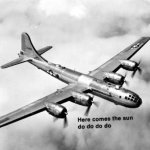The Boeing B-29 Superfortress is an American four-engined propeller-driven heavy bomber, designed by Boeing and flown primarily by the United States during World War II and the Korean War. Named in allusion to its predecessor, the B-17 Flying Fortress, the Superfortress was designed for high-altitude strategic bombing, but also excelled in low-altitude night incendiary bombing, and in dropping naval mines to blockade Japan. B-29s dropped the atomic bombs on Hiroshima and Nagasaki, the only aircraft ever to drop nuclear weapons in combat.
One of the largest aircraft of World War II, the B-29 was designed with state-of-the-art technology, which included a pressurized cabin, dual-wheeled tricycle landing gear, and an analog computer-controlled fire-control system that allowed one gunner and a fire-control officer to direct four remote machine gun turrets. The $3 billion cost of design and production (equivalent to $45 billion today),[3] far exceeding the $1.9 billion cost of the Manhattan Project, made the B-29 program the most expensive of the war.[4][5] The B-29 remained in service in various roles throughout the 1950s, being retired in the early 1960s after 3,970 had been built. A few were also used as flying television transmitters by the Stratovision company. The Royal Air Force flew the B-29 as the Washington until 1954.
 Caption this Meme
Caption this Meme